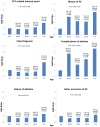Influence of advancing age on clinical presentation, treatment efficacy and safety, and long-term outcome of inducible paroxysmal supraventricular tachycardia without pre-excitation syndromes: A cohort study of 1960 patients included over 25 years
- PMID: 29304037
- PMCID: PMC5755731
- DOI: 10.1371/journal.pone.0187895
Influence of advancing age on clinical presentation, treatment efficacy and safety, and long-term outcome of inducible paroxysmal supraventricular tachycardia without pre-excitation syndromes: A cohort study of 1960 patients included over 25 years
Abstract
Aim: To investigate the influence of increasing age on clinical presentation, treatment and long-term outcome in patients with inducible paroxysmal supraventricular tachycardia (SVT) without pre-excitation syndromes.
Methods: Clinical and electrophysiological study (EPS) data, as well as long-term clinical outcome (mean follow-up 2.4±4.0 years) were collected in patients referred for regular tachycardia with inducible SVT during EPS without pre-excitation.
Results: Among 1960 referred patients, 301 patients (15.4%) were aged ≥70 (70-97). In this subset, anticoagulants were prescribed in 49 patients following an erroneous diagnosis of atrial tachycardia and 14 were previously erroneously diagnosed with ventricular tachycardia because of wide QRS. Ablation was performed more frequently in patients ≥70 despite more frequent failure and complications. During follow-up, higher risks of AF, stroke, pacemaker implantation and death were observed in patients ≥70 whereas SVT recurrences were similar in both age groups. In multivariable analysis, age ≥70 was independently associated with higher risks of SVT-related adverse events prior to ablation (OR = 1.93, 1.41-2.62, p<0.001), conduction disturbances (OR = 11.27, 5.89-21.50, p<0.001), history of AF (OR = 2.18, 1.22-3.90, p = 0.009) and erroneous diagnosis at baseline (OR = 9.14, 5.93-14.09, p<0.001) as well as high rates of procedural complications (OR = 2.13, 1.19-3.81, p = 0.01) and ablation failure (OR = 1.68, 1.08-2.62, p = 0.02). In contrast, age ≥70 was not significantly associated with a higher risk of AF in multivariable analysis.
Conclusions: A sizeable proportion of patients with inducible SVT without pre-excitation syndromes are elderly. These patients exhibit higher risks of erroneous tachycardia diagnosis prior to EPS as well as failure and/or complication of ablation, but similar risk of SVT recurrence. These results support performing transesophageal EPS in most patients and intracardiac EPS in selected patients. EPS may furthermore prove useful in elderly patients with regular tachycardia, mainly by avoiding treatment based on an erroneous diagnosis.
Conflict of interest statement
Figures



Similar articles
-
Influence of advancing age on clinical presentation, treatment efficacy and safety, and long-term outcome of pre-excitation syndromes: a retrospective cohort study of 961 patients included over a 25-year period.BMJ Open. 2016 May 17;6(5):e010520. doi: 10.1136/bmjopen-2015-010520. BMJ Open. 2016. PMID: 27188807 Free PMC article.
-
Follow-up of children or teenagers with paroxysmal supraventricular tachycardia, but without pre-excitation syndrome.Arch Cardiovasc Dis. 2017 Nov;110(11):599-606. doi: 10.1016/j.acvd.2017.01.013. Epub 2017 Jul 24. Arch Cardiovasc Dis. 2017. PMID: 28751003
-
Electrophysiological studies in patients with paroxysmal supraventricular tachycardias but no electrocardiogram documentation: findings from a prospective registry.Europace. 2015 May;17(5):801-6. doi: 10.1093/europace/euu332. Europace. 2015. PMID: 25926475
-
Update: Arrhythmias (V). Paroxysmal supraventricular tachycardias and preexcitation syndromes.Rev Esp Cardiol (Engl Ed). 2012 May;65(5):456-69. doi: 10.1016/j.recesp.2011.11.026. Epub 2012 Mar 28. Rev Esp Cardiol (Engl Ed). 2012. PMID: 22459483 Review. English, Spanish.
-
Interventional electrophysiology and its role in the treatment of cardiac arrhythmia.Ann Acad Med Singap. 1998 Mar;27(2):248-54. Ann Acad Med Singap. 1998. PMID: 9663319 Review.
Cited by
-
Hospitalization rate of paroxysmal supraventricular tachycardia in Sweden.Ann Med. 2018 Nov;50(7):556-564. doi: 10.1080/07853890.2018.1521525. Epub 2018 Oct 15. Ann Med. 2018. PMID: 30192639 Free PMC article.
-
Five Criteria Predict Induction and Ablation of Supraventricular Tachycardia.J Cardiovasc Electrophysiol. 2025 Jan;36(1):220-234. doi: 10.1111/jce.16496. Epub 2024 Nov 18. J Cardiovasc Electrophysiol. 2025. PMID: 39558448 Free PMC article.
References
-
- Furberg CD, Psaty BM, Manolio TA, Gardin JM, Smith VE, Rautaharju PM. Prevalence of atrial fibrillation in elderly subjects (the Cardiovascular Health Study). Am J Cardiol. 1994; 74: 236–41. - PubMed
-
- Kirchhof P, Benussi S, Kotecha D, Ahlsson A, Atar D, Casadei B, et al. 2016 ESC Guidelines for the management of atrial fibrillation developed in collaboration with EACTS. Eur Heart J. 2016; 37: 2893–962. doi: 10.1093/eurheartj/ehw210 - DOI - PubMed
-
- Page RL, Joglar JA, Caldwell MA, Calkins H, Conti JB, Deal BJ, et al. 2015 ACC/AHA/HRS Guideline for the Management of Adult Patients With Supraventricular Tachycardia: A Report of the American College of Cardiology/American Heart Association Task Force on Clinical Practice Guidelines and the Heart Rhythm Society. J Am Coll Cardiol. 2016; 67: e27–e115. doi: 10.1016/j.jacc.2015.08.856 - DOI - PubMed
-
- Patel A, Markowitz SM. Atrial tachycardia: mechanisms and management. Expert Rev Cardiovasc Ther. 2008; 6: 811–22. doi: 10.1586/14779072.6.6.811 - DOI - PubMed
-
- Orejarena LA, Vidaillet H Jr., DeStefano F, Nordstrom DL, Vierkant RA, Smith PN, et al. Paroxysmal supraventricular tachycardia in the general population. J Am Coll Cardiol. 1998; 31: 150–7. - PubMed
Publication types
MeSH terms
LinkOut - more resources
Full Text Sources
Other Literature Sources

